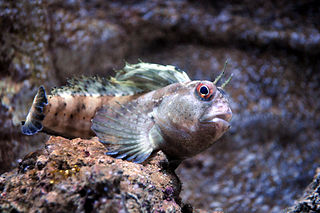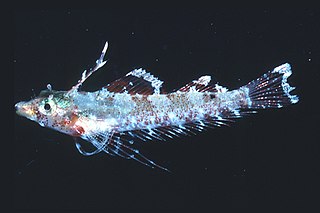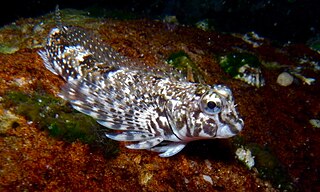
The blennioid family Chaenopsidae includes the pike-blennies, tube-blennies, and flagblennies, all percomorph marine fish in the order Blenniiformes. The family is strictly tropical, ranging from North to South America. Members are also present in waters off Japan, Taiwan and Korea. Fourteen genera and 90 species are represented, the largest being the sarcastic fringehead, Neoclinus blanchardi, at 30 cm (12 in) in length; most are much smaller, and the group includes perhaps the smallest of all vertebrates, Acanthemblemaria paula, measuring just 1.3 cm (0.51 in) long as an adult.

The tompot blenny is a species of combtooth blenny from the north eastern Atlantic Ocean which is found in shallow, coastal waters off western Europe, the Mediterranean and North Africa.
Aristochromis christyi is a species of fish in the family Cichlidae, which is endemic to Lake Malawi in Africa. It is the only known member of its genus.

The nkhomo-benga peacock, also known as the new yellow regal peacock, is a species of haplochromine cichlid which is endemic to Lake Malawi. This species is threatened by capture for the aquarium trade.

The blue lyretail, also known as the Gardner's killi and formerly as the steel-blue aphyosemion. It is a species of killifish endemic to freshwater habitats in Nigeria and Cameroon.

Montagu's blenny, also known as the capuchin blenny, is a species of combtooth blenny found in the intertidal zones of the eastern Atlantic ocean from England to Madeira and the Canary Islands as well the Mediterranean Sea, the Black Sea and the Sea of Marmara. This species prefers rocky shores with much wave action. This species grows to a length of 7.6 centimetres (3.0 in) SL. It is the only species in the genus Coryphoblennius.
Hypleurochilus langi is a species of combtooth blenny found in the eastern Atlantic ocean, from Senegal to the mouth of the Congo River. This species grows to a length of 7 centimetres (2.8 in) SL. This blenny is euryhaline and it enters mouths of large rivers and occurs among mangroves, it prefers brackish water. The specific name of this blenny honours the German zoologist and taxidermist Herbert Lang (1879-1957) of the American Museum of Natural History, who helped to collect the type.

Hypsoblennius invemar, commonly known as the tessellated blenny, is a species of combtooth blenny found in the western Atlantic Ocean.

Istiblennius dussumieri, the streaky rockskipper, is a species of combtooth blenny found in coral reefs in the western Pacific and Indian Oceans. It is also commonly known as the Dussumier's rockskipper, streaky dussumier, or the Dussumier's blenny.

Ophioblennius steindachneri, the large-banded blenny or the Panamic fanged blenny, is a species of combtooth blenny found in coral reefs in the eastern Pacific ocean. This species reaches a length of 18 centimetres (7.1 in) SL.

Acanthemblemaria maria, the secretary blenny, is a species of chaenopsid blenny found in shallow seas in the western central Atlantic Ocean and the Caribbean Sea. It can reach a maximum length of 5 cm (2.0 in) TL.
Emblemaria walkeri, the elusive signal blenny, is a species of chaenopsid blenny found in the Gulf of California, in the eastern central Pacific ocean. It can reach a maximum length of 6.5 centimetres (2.6 in) TL. This species feeds primarily on zooplankton. The specific name honours fisheries biologist Boyd W. Walker (1917-2001) of the University of California, Los Angeles.
Neoclinus stephensae, the yellowfin fringehead, is a species of chaenopsid blenny found in the eastern Pacific ocean. It can reach a maximum length of 10 centimetres (3.9 in) TL. The specific name honours the collector of the type, the British-American conchologist Kate Stephens who was Curator of Mollusks and Marine Invertebrates at San Diego Natural History Museum and who was over 100 years old at the time the species was described.
Labrisomus xanti, the Largemouth blenny, is a species of labrisomid blenny native to the Pacific coast of Mexico from Baja California to Jalisco. It inhabits shallow waters. This species can reach a length of 17.8 centimetres (7.0 in) TL. The specific name honours the collector of the type, the Hungarian zoologist John Xantus (1825-1894).

Starksia spinipenis, the phallic blenny, is a species of labrisomid blenny native to the Pacific coast of Mexico from the Gulf of California to Acapulco. It prefers shallow sandy areas with weed growth. This species can reach a length of 5 centimetres (2.0 in) TL. The specific name is a compound noun if spinis meaning "spine" and penis, a reference to the first spine in the anal fin of the males which is elongated and free of the fin membrane and is modified as a copulatory organ, a characteristic of the genus Starksia.

The black-faced blenny is a small benthic fish from the family Tripterygiidae (triplefin-blennies). It occurs at depths of 3 to 40 metres and lives on the substrate under large rocks, cliffs or other overhangs.

Enneapterygius mirabilis, the miracle triplefin, is a species of triplefin blenny in the genus Enneapterygius. It was described by Ronald Fricke in 1994 who gave it the specific name mirabilis, meaning "admirable", because its notable large pectoral fins and first dorsal fin were pretty.

Lepidoblennius haplodactylus, known commonly as the eastern jumping blenny, is a species of triplefin blenny in the genus Lepidoblennius. It was described by Franz Steindachner in 1867 and is the type species of the genus Lepidoblennius.

The saddleback gunnel, also known as the saddled blenny, is a species of marine ray-finned fish belonging to the family Pholidae, the gunnels. This fish occurs in the shallow coastal waters of the eastern North Pacific Ocean.
The radiated shanny is a species of marine ray-finned fish belonging to the family Stichaeidae, the pricklebacks and shannies. It is the only species in the monotypic genus Ulvaria. This fish is found in the northwestern Atlantic Ocean.

















